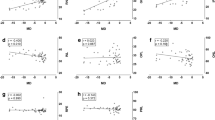Abstract
Purpose
Retinal nerve fiber layer (RNFL) will show retrograde degeneration following damage to the optic nerve or the optic tract in patients with pituitary adenoma. RNFL changes after surgery have not been studied thoroughly in patients with the transsphenoidal surgery and patients with the transcranial surgery.
Methods
Thirty-seven patients with pituitary adenoma were recruited from Huashan hospital between September 2010 and July 2014. Patients were divided into two groups: the transsphenoidal group and the transcranial group. Before surgery, 3 and 9 months after surgery, follow-up optic coherence tomography were conducted.
Results
Twenty-one patients underwent transsphenoidal surgery and 16 patients underwent transcranial surgery. No obvious difference were observed between these two groups before surgery. The mean RNFL thickness did not change significantly in patients who underwent transsphenoidal surgery: 91.1 before surgery, 92.7 at 3 months after surgery (p = 0.392) and 92.8 at 9 months after surgery (p = 0.395). The mean RNFL thickness decreased in patients who underwent transcranial surgery: 93.6 before surgery, 86.1 at 3 months after surgery (p = 0.000) and 88.1 at 9 months after surgery (p = 0.005).
Conclusions
In the short time follow-up, there was no change of RNFL thickness in pituitary adenoma patients underwent transsphenoidal surgery, but a decrease in patients underwent transcranial surgery.







Similar content being viewed by others
References
Melmed S (2015) Pituitary tumors. Endocrinol Metab Clin North Am 44:1–9
Mayson SE, Snyder PJ (2006) Silent pituitary adenomas. Endocrinol Metab Clin North Am 44:79–87
Trip SA, Schlottmann PG, Jones SJ (2006) Optic nerve atrophy and retinal nerve fibre layer thinning following optic neuritis: evidence that axonal loss is a substrate of MRI-detected atrophy. NeuroImage 3:286–293
Johansson C, Lindblom B (2009) The role of optical coherence tomography in the detection of pituitary adenoma. Acta Ophthalmol 87:776–779
Jacob M, Raverot G, Jouanneau E (2009) Predicting visual outcome after treatment of pituitary adenomas with optical coherence tomography. Am J Ophthalmol 147(64–70):e2
Klistorner A, Arvind H, Garrick R, Graham SL, Paine M, Yiannikas C (2010) Interrelationship of optical coherence tomography and multifocal visual-evoked potentials after optic neuritis. Invest Ophthalmol Vis Sci 51:2770–2777
Moon CH, Hwang SC, Ohn Y-H, Park TK (2011) The time course of visual field recovery and changes of retinal ganglion cells after optic chiasmal decompression. Invest Ophthalmol Vis Sci 52:7966–7973
Weber AJ, Harman CD, Viswanathan S (2008) Effects of optic nerve injury, glaucoma, and neuroprotection on the survival, structure, and function of ganglion cells in the mammalian retina. J Physiol (Lond) 586:4393–4400
Sriram P, Wang C, Yiannikas C (2014) Relationship between optical coherence tomography and electrophysiology of the visual pathway in non-optic neuritis eyes of multiple sclerosis patients. PLoS One 9:e102546
Klistorner A, Arvind H, Garrick R, Graham SL, Paine M, Yiannikas C (2010) Interrelationship of optical coherence tomography and multifocal visual-evoked potentials after optic neuritis. Invest Ophthalmol Vis Sci 51:2770–2777
Kolappan M, Henderson APD, Jenkins TM (2009) Assessing structure and function of the afferent visual pathway in multiple sclerosis and associated optic neuritis. J Neurol 256:305–319
Toosy AT, Hickman SJ, Miszkiel KA (2005) Adaptive cortical plasticity in higher visual areas after acute optic neuritis. Ann Neurol 57:622–633
Gnanalingham KK, Bhattacharjee S, Pennington R, Ng J, Mendoza N (2005) The time course of visual field recovery following transsphenoidal surgery for pituitary adenomas: predictive factors for a good outcome. J Neurol Neurosurg Psychiatr 76:415–419
Barzaghi LR, Medone M, Losa M, Bianchi S, Giovanelli M, Mortini P (2012) Prognostic factors of visual field improvement after trans-sphenoidal approach for pituitary macroadenomas: review of the literature and analysis by quantitative method. Neurosurg Rev 35:369–378 discussion 378–9
Author information
Authors and Affiliations
Corresponding author
Ethics declarations
Conflict of interest
None.
Rights and permissions
About this article
Cite this article
Qiao, N., Ye, Z., Shen, M. et al. Retinal nerve fiber layer changes after transsphenoidal and transcranial pituitary adenoma resection. Pituitary 19, 75–81 (2016). https://doi.org/10.1007/s11102-015-0689-7
Published:
Issue Date:
DOI: https://doi.org/10.1007/s11102-015-0689-7




